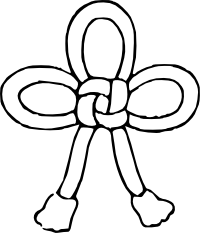Recreational research into Feudal Japan
Archive for November, 2010
Mon of the Week: Knot
Nov 28th (a Tomobiki (友引))
Continuing with the provincial samurai mon, we have this simple depiction of a knot.(KJ:7)
This is not just any knot, however. This knot is called “agemaki” (総角) and auspiciously symbolizes the four directions. It is hung above sumo rings, and was used on samurai armor both for decoration and as a structural component.(Samurai Weapons) For these reasons and its graphical simplicity, it makes a lot of sense as a samurai mon. Slightly more stylized depictions continue to be used in mon today,(Kamon Composition Maker) albeit rarely.
Less relevantly, it names a similar-looking historical (but later) hairstyle and type of dance in kabuki. Nowadays, they are used to decorate cars in Japan’s “VIP style”.(Diamond Zeus)
On Kissing
Nov 22nd (a Tomobiki (友引))
Once, many years ago, I read the following in Shinjū, by Laura Joh Rowland, a mystery novel set in Edo Japan.
But he’d never tried seppun, the exotic practice of touching mouths that had been introduced to Japan by the banished foreign barbarians. (p. 123)
Being naturally a trusting sort, I took this at face value and assumed the Japanese hadn’t kissed before the Portuguese arrived in 1542. But more recently, I read an interesting passage in the Tosa Journal, written around 935 by a courtier.(CJP:77)
People simply kissed the lips of pressed salted trout. (I.e., nibbled at their heads.) Do you suppose the trout found it romantic?
Is this evidence of pre-Western-influence romantic kissing? Certainly looks like it. But absent other evidence, I had to wonder what exactly was in the original and if anything had been added in translation. Looking at the original, several things are clear. The expression here is “kuchi wo sufu”1, literally “suck lips”, which does seem to specifically be an idiom for kissing. The romantic bit turns out to be “omofu yau ara n ya”, something along the lines of “perhaps they helplessly have longing”, omofu having among its various possible interpretations ‘think of’, ‘recall fondly’, ‘long for’, ‘love’, and ‘cherish’. I think we can fairly say, then, that my doubts of Dr. McCullough’s translation were unmerited. As for Westerners having introduced romantic kissing to the Japanese, as we say in the biz, “Myth Busted!”
I have also posted a complete translation of these two sentences.
Many thanks to Mister Bean (ミスター ビーン), whose analysis and translation of this passage into modern Japanese was quite helpful.

